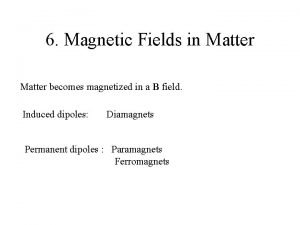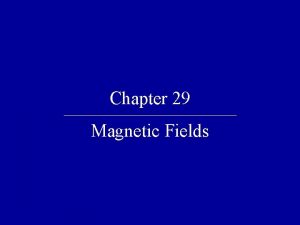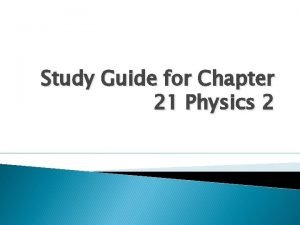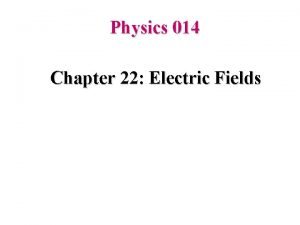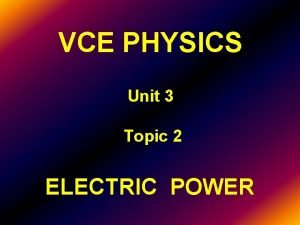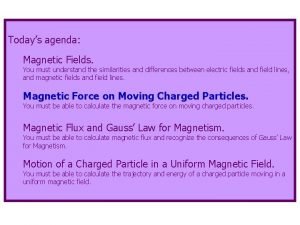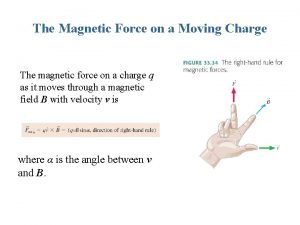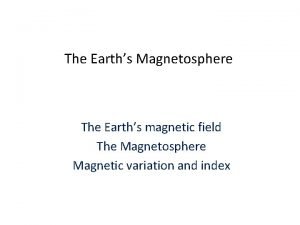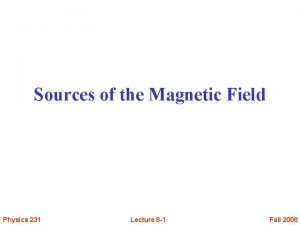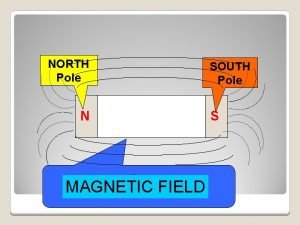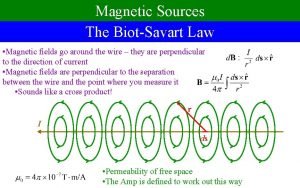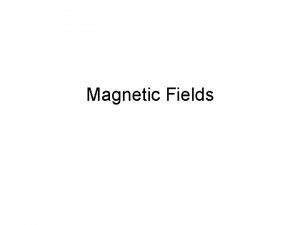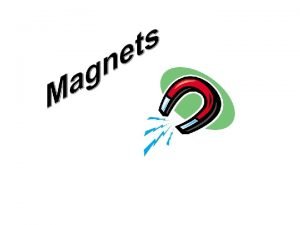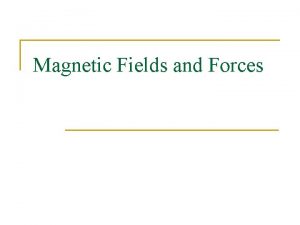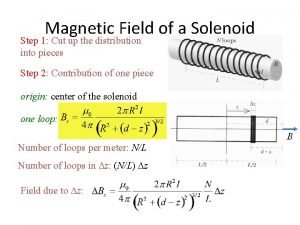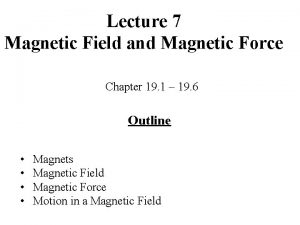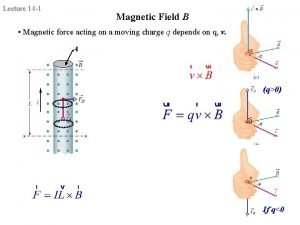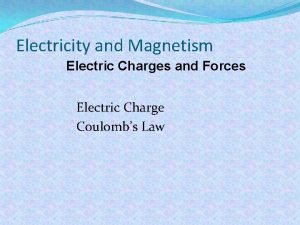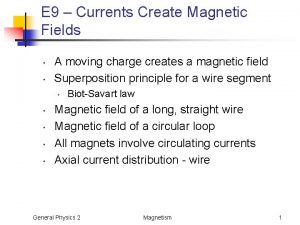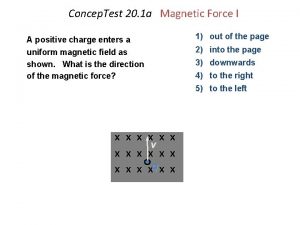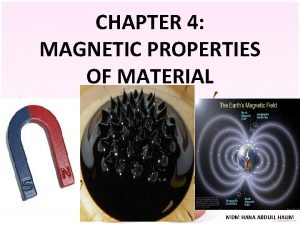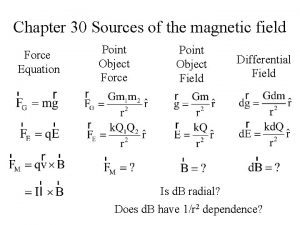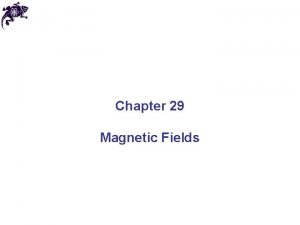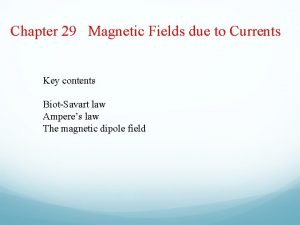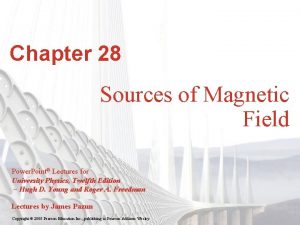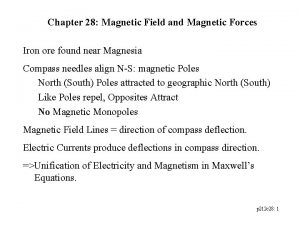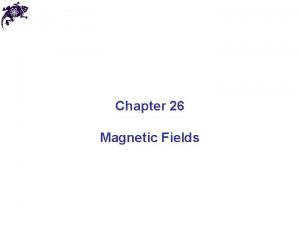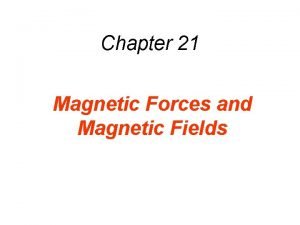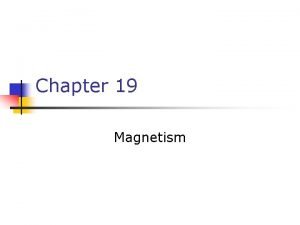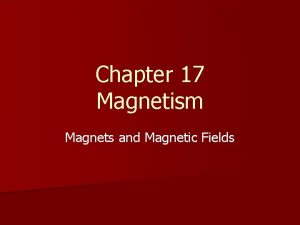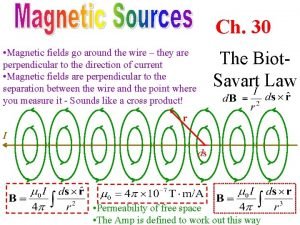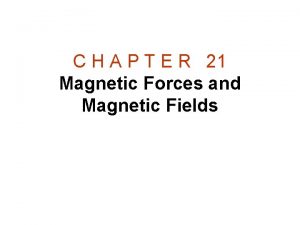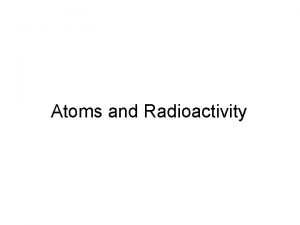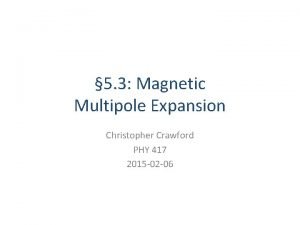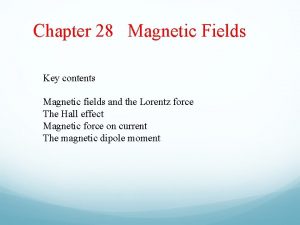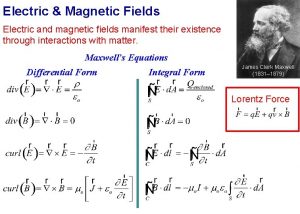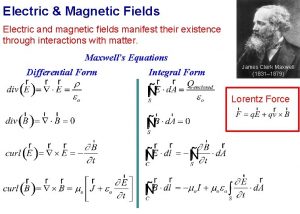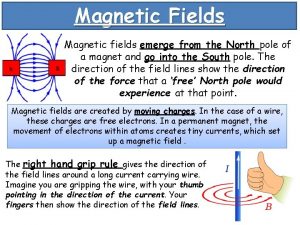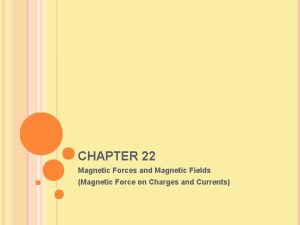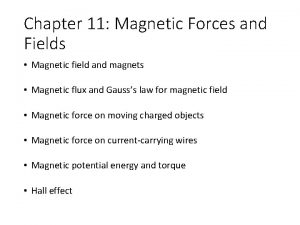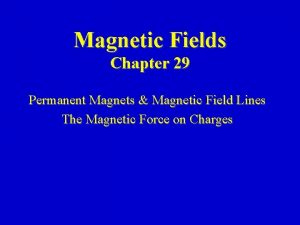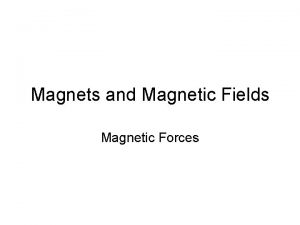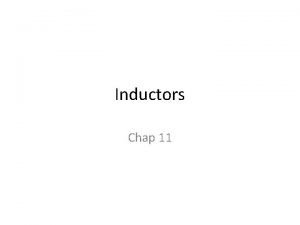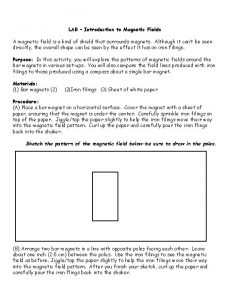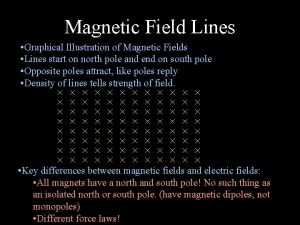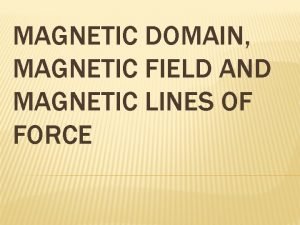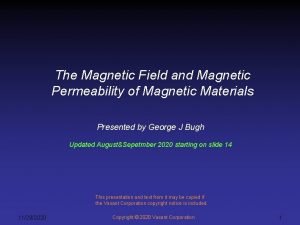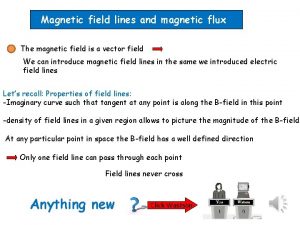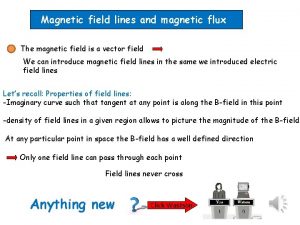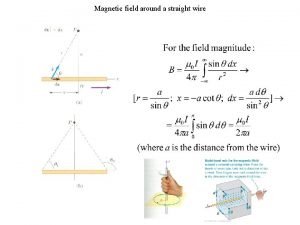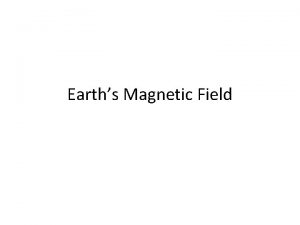Chapter 29 Magnetic Field 29 1 Magnetic Fields


















![Example [6] A proton moves with a velocity of v = (2 iˆ- 4 Example [6] A proton moves with a velocity of v = (2 iˆ- 4](https://slidetodoc.com/presentation_image_h2/9cd30c32c3473c4f9cd699cd9a9d7a12/image-19.jpg)



































- Slides: 54

Chapter 29 Magnetic Field 29. 1 Magnetic Fields and Forces 29. 2 Magnetic Force Acting on a Current Carrying Conductor 29. 4 Motion of a Charged Particle in a Uniform Magnetic Field 29. 5 Applications Involving Charged Particles Moving in a Magnetic Field

29. 1 Magnetic Fields and Forces §The direction of the magnetic field B at any location is the direction in which a compass needle points at that location. The magnetic field lines outside the magnet point away from north poles and toward south poles. Active Figure 29. 1 Compass needles can be used to trace the magnetic field lines in the region outside a bar magnet

§ We can define a magnetic field B at some point in space in terms of the magnetic force FB that the field exerts on a test object, for which we use a charged particle moving with a velocity v. v assuming that no electric (E) or gravitational (g) fields are present at the location of the test object. Figure 29. 3 The direction of the magnetic force FB acting on a charged particle moving with a velocity v in the presence of a magnetic field B. (a) The magnetic force is perpendicular to both v and B. Henry Leap and Jim Lehman The formula: q is the charge is velocity of the charge is the magnetic force is the magnetic field

• The magnitude FB of the magnetic force exerted on the particle is proportional to the charge q and to the speed v of the particle • The magnitude and direction of FB depend on the velocity of the particle V and on the magnitude and direction of the magnetic field B. • When a charged particle moves parallel to the magnetic field vector (i. e. , θ = 0) , the magnetic force acting on the particle is zero. • When the particle’s velocity vector makes any angle with the magnetic field, the magnetic force acts in a direction perpendicular to both v and B; FB is perpendicular to the plane formed by v and Bb The magnitude: For a positive charge or When the velocity and the field are perpendicular to each other.

Fig 29 -3 b, p. 897 • The magnetic force exerted on a positive charge is in the direction opposite the direction of the magnetic force exerted on a negative charge moving in the same direction. • The magnitude of the magnetic force exerted on the moving particle is proportional to sin , where is the angle the particle’s velocity vector makes with the direction of B. We can summarize these observations by writing the magnetic force in the form • The SI unit of magnetic field is the tesla (T) = Kg / C. s – Wb (Weber) is the unit for magnetic field flux. • A non-SI commonly used unit is a gauss (G) – 1 T = 104 G

For positive charge J x-I = k

Figure 29. 6 (a) Magnetic field lines coming out of the paper are indicated by dots, representing the tips of arrows coming outward. (b) Magnetic field lines going into the paper are indicated by crosses, representing the feathers of arrows going inward. • If B is in the page, we use lines with arrow heads. • • Right Hand Rule Hold your right hand open Place your fingers in the direction of B Place your thumb in the direction of v The direction of the force on a positive charge is directed out of your palm – If the charge is negative, the force is opposite that determined by the right hand rule

What is the direction of the force F on the charge in each of the examples described below? X X F X X Xv X X + X X · · · · F · · ·v · negative q · · · Up Left Up v X X X FX X X X + X X · · · · · v · · ·F · · Right


Differences Between Electric and Magnetic Fields • Direction of force – The electric force acts parallel or antiparallel to the electric field (FE = q. E) – The magnetic force acts perpendicular to the magnetic field • FB = |q| v B sin q – q is the angle between the velocity and the field – The force is zero when the velocity and the field are parallel or antiparallel q=0 or q = 180 o – The force is a maximum when the velocity and the field are perpendicular q = 90 o

Motion The electric force acts on a charged particle regardless of its velocity The magnetic force acts on a charged particle only when the particle is in motion and the force is proportional to the velocity • Work – The electric force does work in displacing a charged particle – The magnetic force associated with a steady magnetic field does no work when a particle is displaced • This is because the force is perpendicular to the displacement

• The kinetic energy of a charged particle moving through a constant magnetic field cannot be altered by the magnetic field alone • When a charged particle moves with a velocity through a magnetic field, the field can alter the direction of the velocity, but not the speed or the kinetic energy

Example. A 2 -n. C charge is projected with velocity 5 x 104 m/s at an angle of 300 with a 3 m. T magnetic field as shown. What are the magnitude and direction of the resulting force? q = 2 x 10 -9 C v = 5 x 104 m/s B = 3 x 10 -3 T q = 300 F B v Resultant Magnetic Force: F = 1. 50 x 10 -7 N, upward

Example A proton moves with a speed of 1. 0 x 105 m/s through the Earth’s magnetic field, which has a value of 55 m. T at a particular location. When the proton moves eastward, the magnetic force is a maximum, and when it moves northward, no magnetic force acts upon it. What is the magnitude and direction of the magnetic force acting on the proton? The direction cannot be determined precisely by the given information. Since no force acts on the proton when it moves northward (meaning the angle is equal to ZERO), we can infer that the magnetic field must either go northward or southward.

Example Determine the direction of the unknown variable for a proton moving in the field using the coordinate axis given B = -x v = +y F = +z +y +z +x B =+Z v = +x F = -y B = -z v = +y F = -x

Example Determine the direction of the unknown variable for an electron using the coordinate axis given. +y +z B = +x v = +y F = +z +x F B = -z v=-x F = +y B B = +z v = +x F = +y

Example the force on a fast moving proton due to the earth’s magnetic field. (Already we know we can neglect gravity, but can we neglect magnetism? ) Let v = 107 m/s moving North. E = 100 V/m What is the direction and magnitude of F? Take B = 0. 5 x 10 -4 T and v B to get maximum effect. (a very fast-moving proton) vx. B is into the paper (west). F v B N

Example A charge q 1 = 25. 0 μC moves with a speed of 4. 5 x 103 m/s perpendicularly to a uniform magnetic field. The charge experiences a magnetic force of 7. 31 x 10 -3 N. A second charge q 2 = 5. 00 μC travels at an angle of 40. 0 o with respect to the same magnetic field and experiences a 1. 90 x 10 -3 N force. Determine (i) The magnitude of the magnetic field and (ii) The speed of q 2. q 1 = 25. 0 μC , v 1 = 4. 5 x 103 m/s, Ө 1= 90. 0 o F 1 = 7. 31 x 10 -3 N, q 2 = 5. 00 μC, Ө 2 = 40. 0 o, F 2 = 1. 90 x 10 -3 N force. (i) (ii) v 2 = 9. 10 x 103 m/s
![Example 6 A proton moves with a velocity of v 2 iˆ 4 Example [6] A proton moves with a velocity of v = (2 iˆ- 4](https://slidetodoc.com/presentation_image_h2/9cd30c32c3473c4f9cd699cd9a9d7a12/image-19.jpg)
Example [6] A proton moves with a velocity of v = (2 iˆ- 4 jˆ +kˆ ) m/s in a region in which the magnetic field is B " (iˆ + 2 jˆ - 3 kˆ ) T. What is the magnitude of the magnetic force this charge experiences?

Example Magnetic Forces on Charged Particles A proton in a particle accelerator has a speed of 5. 0 x 106 m/s. The proton encounters a magnetic field whose magnitude is 0. 40 T and whose direction makes and angle of 30. 0 degrees with respect to the proton’s velocity (see part (c) of the figure). Find (a) the magnitude and direction of the force on the proton and (b) the acceleration of the proton. (c) What would be the force and acceleration if the particle were an electron?

An electron in a television picture tube moves toward the front of the tube with a speed of 8. 0 x 106 m/s along the x axis. Surrounding the neck of the tube are coils of wire that create a magnetic field of magnitude 0. 025 T, directed at an angle of 60° to the x axis and lying in the xy plane. Calculate the magnetic force on and acceleration of the electron.

Example 3 - An electron moving along the positive x axis perpendicular to a magnetic field experiences a magnetic deflection in the negative y direction. What is the direction of the magnetic field?

Example 5 - A proton moves in a direction perpendicular to a uniform magnetic field B at 1. 0 x 107 m/s and experiences an acceleration of 2. 0 x 1013 m/s 2 in the + x direction when its velocity is in the +z direction. Determine the magnitude and direction of the field.

Example 1. Calculate the magnitude of the force on a proton travelling 3. 1 x 107 m s-1 in the uniform magnetic flux density of 1. 6 Wb m-2, if : (i) the velocity of the proton is perpendicular to the magnetic field. (ii) the velocity of the proton makes an angle 60 with the magnetic field. (charge of the proton = +1. 60 x 10 -19 C)

29. 2 Magnetic Force Acting on a Current - Carrying Conductor If a magnetic force is exerted on a single charged particle when the particle moves through a magnetic field, it should not surprise you that a currentcarrying wire also experiences a force when placed in a magnetic field. the current is a collection of many charged particles in motion; hence, the resultant force exerted by the field on the wire is the vector sum of the individual forces exerted on all the charged particles making up the current. The force exerted on the particles is transmitted to the wire when the particles collide with the atoms making up the wire.

Direction: Right-hand rule F=0 when θ = 00 I//B Fmax=Il. B when θ =90 o I B • F is maximum when Ө=90 o Fig 29 -8, p. 901

Example: A wire carries a current of 22 A from east to west. Assume that at this location the magnetic field of the earth is horizontal and directed from south to north, and has a magnitude of 0. 50 x 10 -4 T. Find the magnetic force on a 36 m length of wire. What happens if the direction of the current is reversed?

Example Determine the direction of the magnetic force, exerted on a conductor carrying current, I in each problem below. a. b. X X X X a. X X X X X X X X (to the right) X X X X (to the left) X b.

Example A wire of length 0. 655 m carries a current of 21. 0 A. In the presence of a 0. 470 T magnetic field, the wire experiences a force of 5. 46 N. What is the angle (less than 90 o) between the wire and the magnetic field?

Example 1. A square coil of wire containing a single turn is placed in a uniform 0. 25 T magnetic field. Each side has a length of 0. 32 m, and the current in the coil is 12 A. Determine the magnitude of the magnetic force on each of the four sides. 90 o B I 0. 96 N (top and bottom sides) 0 N (left and right sides)

Example 13 - A wire having a mass per unit length of 0. 500 g/cm carries a 2. 00 -A current horizontally to the south. What are the direction and magnitude of the minimum magnetic field needed to lift this wire vertically upward?

Example 16 - A conductor suspended by two flexible wires as shown in Figure P 29. 16 has a mass per unit length of 0. 040 0 kg/m. What current must exist in the conductor for the tension in the supporting wires to be zero when the magnetic

Example A 36 -m length wire carries a current of 22 A running from right to left. Calculate the magnitude and direction of the magnetic force acting on the wire if it is placed in a magnetic field with a magnitude of 0. 50 x 10 -4 T and directed up the page. +y 0. 0396 N B = +y +z I = -x F = -z, into the page +x

Magnetic Force on a Current Example: A current, I=10 A, flows through a wire, of length L=20 cm, between the poles of a 1000 Gauss magnet. The wire is at q = 900 to the field as shown. What is the force on the wire? L (up) I I F • L [F points out of the page] N S

Example : The Force and Acceleration in a Loudspeaker The voice coil of a speaker has a diameter of 0. 0025 m, contains 55 turns of wire, and is placed in a 0. 10 -T magnetic field. The current in the voice coil is 2. 0 A. (a) Determine the magnetic force that acts on the coil and the cone. (b) The voice coil and cone have a combined mass of 0. 0200 kg. Find their acceleration.

29. 4 Motion of a Charged Particle in a Uniform Magnetic Field The magnetic force acting on a charged particle moving in a magnetic field is perpendicular to the velocity of the particle and that consequently the work done on the particle by the magnetic force is zero. (W= F. S= Fs cos θ) Because FB always points toward the center of the circle, it changes only the direction of v and not its magnitude. the rotation is counterclockwise for a positive charge. If q were negative, the rotation would be clockwise.

X X X X B into the page X B out of the page

r is proportional mass of the particle and inversely proportional to the magnetic field and the charge The angular speed of the particle The period of the motion T (the time that the particle takes to complete one revolution) is equal to the circumference of the circle divided by the linear speed of the particle: Figure 29. 19 A charged particle having a velocity vector that has a component parallel to a uniform magnetic field moves in a helical path.

A proton is moving in a circular orbit of radius 14 cm in a uniform 0. 35 -T magnetic field perpendicular to the velocity of the proton. Find the linear speed of the proton.

29. 5 Applications Involving Charged Particles Moving in a Magnetic Field Velocity Selector: • In many applications, the charged particle will move in the presence of both magnetic and electric fields • In that case, the total force is the sum of the forces due to the individual fields • In general: – This force is called the Lorenz force – It is the vector sum of the electric force and the magnetic force

• Used when all the particles need to move with the same velocity • A uniform electric field is perpendicular to a uniform magnetic field • When the force due to the electric field is equal but opposite to the force due to the magnetic field, the particle moves in a straight line • This occurs for velocities of value v = E / B • Only those particles with the given speed will pass through the two fields undeflected • The magnetic force exerted on particles moving at speed greater than this is stronger than the electric field and the particles will be deflected upward • Those moving more slowly will be deflected downward

Example Suppose a cyclotron is operated at frequency f=12 MHz and has a dee radius of R=53 cm. What is the magnitude of the magnetic field needed for deuterons to be accelerated in the cyclotron (m=3. 34 10 -27 kg)?

Example • A 2. 0 -m wire carrying a current of 0. 60 A is oriented parallel to a uniform magnetic field of 0. 50 T. What is the magnitude of the force it experiences? a) zero b) 0. 60 N c) 0. 15 N d) 0. 30 N

A magnetic force acts on an electric charge (q) in a magnetic field (B) when: (A) q moves at 90° to B (B) q is at rest (C) q moves along B (D) q moves opposite to B (E) None of the above An electron moving in the positive x direction experiences a magnetic force pointing into the plane of the page. The direction of magnetic field (B) that produced this magnetic force is along the: (A) Positive x axis (B) Negative x axis (C) Positive y axis (D) Negative y axis (E) out of the plane

Example Suppose a cyclotron is operated at frequency f=12 MHz and has a dee radius of R=53 cm. What is the kinetic energy of the deuterons in this cyclotron when they travel on a circular trajectory with radius R (m=3. 34 10 -27 kg, B=1. 57 T)? A) 0. 9 10 -14 J B) 8. 47 10 -13 J C) 2. 7 10 -12 J D) 3. 74 10 -13 J

Homework 1 - Find the magnetic force on a proton moving in the +x direction at a speed of 0. 446 Mm/s in a uniform magnetic field of 1. 75 T in the +z direction. 2 -A point particle has a charge equal to – 3. 64 n. C and a velocity equal to 2. 75 x 103 m/s i. Find the force on the charge if the magnetic field is: (a) 0. 38 Tˆ j , (b) 0. 75 Tˆ i +0. 75 Tˆ j , (c) 0. 65 T ˆ i, and (d) 0. 75 T ˆ I + 0. 75 T ˆ k

3 - A uniform magnetic field equal to 1. 48 T is in the +z direction. Find the force exerted by the field on a proton if the velocity of the proton is (a)2. 7 km/s iˆ , (b) 3. 7 km/s jˆ , (c)6. 8 km/sˆ k, and (d)4. 0 km/s iˆ+ 3. 0 km/s j ˆ 4 -

5 - A straight wire segment that is 2. 0 m long makes an angle of 30º with a uniform 0. 37 T magnetic field. Find the magnitude of the force on the wire if the wire carries a current of 2. 6 A. 6 - 7 - A proton moves in a 65 -cm-radius circular orbit that is perpendicular to a uniform magnetic field of magnitude 0. 75 T. (a) What is the orbital period for the motion? (b) What is the speed of the proton? (c) What is the kinetic energy of the proton?

8 - 9 -An alpha particle has a charge of +2 e (e = 1. 6 × 10– 19 C) and is moving at right angles to a magnetic field B = 0. 27 T with a speed v = 6. 15 × 105 m/s. The force acting on this charged particle is 10 -A singly charged positive ion has a mass of 2. 5 x 10 -26 kg. After being accelerated through a potential difference of 250 V, the ion enters a magnetic field of 0. 5 T, in a direction perpendicular to the field. Calculate the radius of the path of the ion in the field.

11 - A proton is moving with velocity 3 x 10 5 m/s vertically across a magnetic field 0. 02 T. (mp = 1. 67 x 10 -27 kg) Calculate ; a) kinetic energy of the proton b) the magnetic force exerted on the proton c) the radius of the circular path of the proton. 12 -An electron is projected from left to right into a magnetic field directed into the page. The velocity of the electron is 2 x 10 6 ms-1 and the magnetic flux density of the field is 3. 0 T. Find the magnitude and direction of the magnetic force on the electron. (charge of electron = 1. 6 x 10 -19 C)

13 -What is the relation between the intensities of the electric and magnetic fields for the particle to move in a straight line ? . E x x x v • q m B



Magnetic Field and Electric Field Deflection of a charged particle in a magnetic field Deflection of a charged particle in an electric field The magnetic field can exert a magnetic force only on a moving charged particle moving perpendicular to the field. Stationary charged particles and charges moving parallel to the field experience no force. The electric field always exerts an electric force on a charged particle, whether it is stationary or moving. The magnetic force is perpendicular to the magnetic field and the direction of motion of the charged particle. Direction of force is deduced by Fleming’s Left Hand Rule. The electric force acts in the direction of the electric field. Deduced from the law of electrostatics (i. e. Like charges repel; unlike charges attract. ) Magnetic force is dependent on the speed and direction of motion of the charged particle: Electric force is independent of the speed and direction of motion of the charged particle. (FE = q. E) Uniform circular motion is obtained when a charged particle enters a magnetic field perpendicularly. Parabolic motion is obtained when a charged particle enters an electric field perpendicularly.
 Red fields to green fields
Red fields to green fields Magnetic moment and magnetic field relation
Magnetic moment and magnetic field relation Air gap length formula
Air gap length formula Force on charged particle
Force on charged particle Gauss law of magnetism
Gauss law of magnetism Q factor of capacitor
Q factor of capacitor Difference between electric field and magnetic field
Difference between electric field and magnetic field Learning: module 26: magnetic forces and fields
Learning: module 26: magnetic forces and fields Lesson outline lesson 1 magnets and magnetic fields
Lesson outline lesson 1 magnets and magnetic fields Magnetic fields in matter
Magnetic fields in matter Magnetic fields quick
Magnetic fields quick Electric currents and magnetic fields
Electric currents and magnetic fields Electric currents and magnetic fields
Electric currents and magnetic fields Difference between magnetic flux and magnetic flux density
Difference between magnetic flux and magnetic flux density Chapter 16: electric forces and fields answers
Chapter 16: electric forces and fields answers Chapter 33 electric fields and potential
Chapter 33 electric fields and potential Chapter 21 study guide electric fields answers
Chapter 21 study guide electric fields answers Chapter 22 electric fields
Chapter 22 electric fields Right hand palm rule magnetic field
Right hand palm rule magnetic field Magnitude of magnetic field
Magnitude of magnetic field Integral of magnetic field
Integral of magnetic field Magnetic field equation
Magnetic field equation Magnetic field unit
Magnetic field unit Characteristics of magnetic field
Characteristics of magnetic field Intrinsic magnetic field
Intrinsic magnetic field Permanent and induced magnets bbc bitesize
Permanent and induced magnets bbc bitesize Magnetic field of a finite wire
Magnetic field of a finite wire Hand rule for magnetic field
Hand rule for magnetic field Cow magnet magnetic field lines
Cow magnet magnetic field lines When is magnetic field zero
When is magnetic field zero Magnetic field lines always cross.
Magnetic field lines always cross. Facts about magnetic forces
Facts about magnetic forces Magnetic field solenoid
Magnetic field solenoid A magnetic force
A magnetic force Magnetic field in a closed loop
Magnetic field in a closed loop Static electricity
Static electricity Electric force equation
Electric force equation Earth magnetic field value
Earth magnetic field value Earth magnetic field value
Earth magnetic field value Physics 2
Physics 2 Right hand rule positive charge
Right hand rule positive charge Paramagnetic diamagnetic ferromagnetic
Paramagnetic diamagnetic ferromagnetic Magnetic field in wire formula
Magnetic field in wire formula Potential energy magnetic field
Potential energy magnetic field Magnetic field outside a wire
Magnetic field outside a wire Conductor in a magnetic field
Conductor in a magnetic field Magnetic field unit
Magnetic field unit Magnetic torque
Magnetic torque Does magnetic field exerts force on a static charge
Does magnetic field exerts force on a static charge Magnetic field equation
Magnetic field equation Force exerted by magnets
Force exerted by magnets Magnetic field of a finite wire
Magnetic field of a finite wire Units of magnetic field
Units of magnetic field Alpha particle in electric field
Alpha particle in electric field Multipole expansion griffiths
Multipole expansion griffiths









